Tom posted yesterday to say that he really doesn’t like manga at all.
All that solid-black hair, those pie-shaped googly eyes and triangle mouths (with rounded corners!), the stunted pseudo-children, the skimpy few words stranded in fat balloons. And never anything in view but more black hair, googly eyes, and a lonely sprinkling of words against white space. Page after page, book after book, truckload after truckload. Manga makes me feel claustrophobic.
He adds:
manga, all manga, carries to an extreme the formal trend followed by US mainstream comics over the past few decades, which is to streamline word-and-picture arrangements so that the eye is always pinging forward with as little drag as possible, even if a concomitant of drag might be better dialogue or more detailed drawing.
That second quote is interesting, because it’s got the formal influence exactly reversed. That is, manga isn’t carrying a U.S. trend anywhere; the influence goes the other way. To the extent that there has been cross-fertilization between manga and American comics over the last decade, most of it’s gone Japan to America, rather than the other way around, I think.
That aside…Tom’s not really making, or attempting to make, an objective argument here, so refuting it is in some sense kind of pointless. If you hate manga art, you hate manga art; I can’t make you like something you don’t.
Still, there are a couple of ways to go with this argument I guess. In the first place, the formal elements you object to seem to be derived mostly form looking at shojo — comics for girls. As Tom somewhat reluctantly noted towards the end of his post, there’s actually a lot of manga out there that looks rather different.
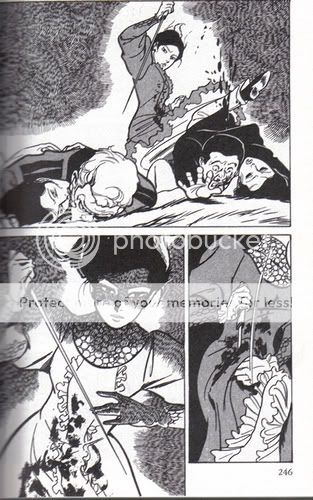
Lady Snowblood, Kazuo Koike and Kazuo Kamimura
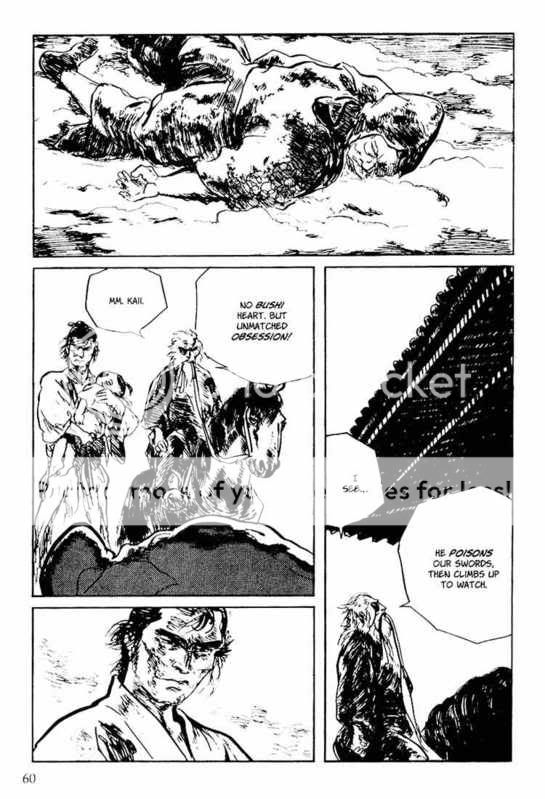
Lone Wolf and Cub, Kazuo Koike and Goseki Kojima
I’m sure Bill could come up with more and better examples, but I think you get the general point; dismissing all manga is like dismissing all American comics…or, more, like dismissing all American movies. It’s a huge medium; if you felt like looking, you could probably find something that you liked.
As for shojo — that’s actually a genre I like a lot. To answer your objections in turn:
1. Stylization — If you don’t like stylization, you don’t like stylization, I guess. If most of the enjoyment you get from art is based on realism and anatomical fidelity, then, yeah, shojo isn’t necessarily the place to be looking. If, on the other hand, you really appreciate patterning, layout, and surface detail, shojo can be amazing.
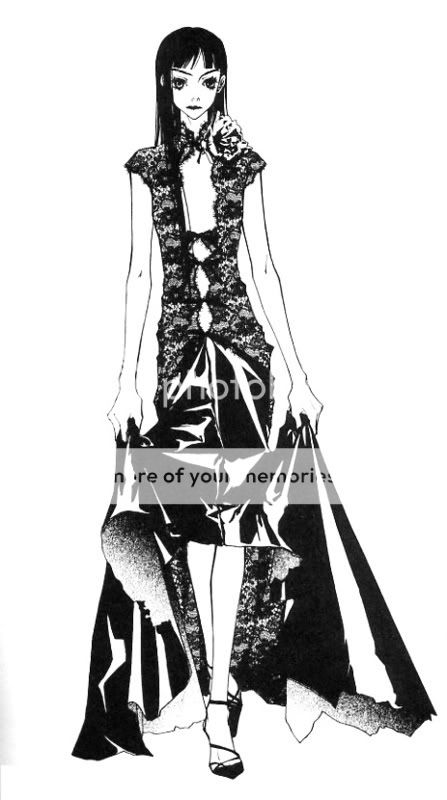
Forest of Gray City, by Jung-Hyun Uhm
I just hardly see anything, ever, in mainstream comics, and precious little in alternative comics, that gets me the way drawings like the above do.
2. Too few words — American comics are extremely wordy. Manga in general (and shojo in particular) are much less so. You seem to see this as a failure on the part of manga. For me it’s the reverse. Manga is extremely good at visual storytelling; in comparison, American comics writing seems extremely tedious, tending to state the obvious over and over and over again. This afflicts superhero comics..but it’s also the case for things like Maus, which goes on and on and on and on and on, almost fetishizing the fact that the pictures are so unnecessary to the story.
When manga (or shojo specifically) doesn’t work, it can be well nigh incomprehensible; I wouldn’t deny that. On the other hand, when it does work, it fuses word and images in a way that’s really sublime. Nana and Let Dai, two of my favorite shojo series, have incredibly nuanced and thoughtful characterization and relationships, much of it conveyed through visual expressions and body posture, just as you would see in, say, a movie or on stage. In comparison, something like Fun Home seems to me incredibly thumb fingered, in every sense — constantly harping on the obvious, much less fluid storytelling, art with a lot less emotional heft, etc.
I’m kind of not the best person to be defending manga, maybe…I haven’t read a ton, and I’m certainly nowhere near being an expert. But in my limited explorations in the genre, I’ve found a number of series that are funny, touching, thoughtful, cool as shit, beautiful — all the things I look for in art, basically. So that’s the point of manga to me.
Or you can read Tucker’s take; first review at the top.
Update: Tom does over his post. His rejiggering of his discussion of manga pacing made me thing more about his point, which in turn made me not quite get what he’s talking about. Tom says manga is all very fast forward movement. I don’t get that at all. On the contrary, people like Ai Yazawa or Sooyeon Won or even Clamp seem much, much more in control of pacing than their Western peers. In Nana especially, the story can bounce along quickly…or it can be slower and more contemplative…or it can freeze in a moment of emotional intensity. It’s true the text is less heavy than in American comics, but there are other ways to slow down the story — close-ups, expression, levels of detail, and so forth.
I guess it’s possible that what’s happening for Tom is that he’s so alienated by the art that he’s not able to pick up on the pacing cues? Anyway, for me, super-hero comics seem to be much more frantically paced…Grant Morrison’s cyberpunky stuff especially often seems just jam-packed with stuff without almost any effort to do visual pacing. Most of the manga stuff I see is very aware and capable of using space for pacing….

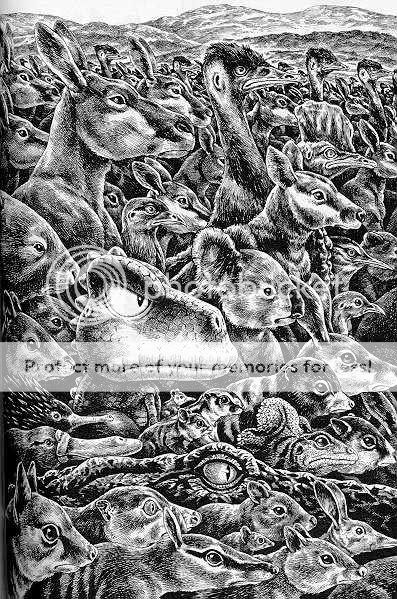
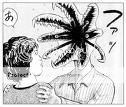
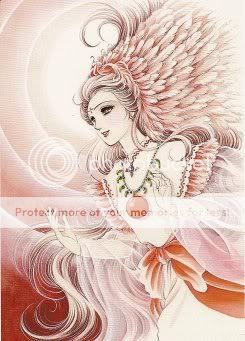
“manga, carries to an extreme the formal trend followed by US mainstream comics over the past few decades,”
Yeah, that’s not really saying US comics have influenced manga. I know that they haven’t. But it could be read as saying US comics have influenced manga, so the wording is faulty.
I don’t know. I think the approach I took in my post was all wrong. Thought I made it clear that I was describing a reflex, an unreasoning response, and that’s all. The fact that there’s nothing to argue against was kind of a given — I thought. But instead of getting cute I should have … ah, screw it.
At least I got blackasthenight but more of the recognition he deserves.
I thought you made it quite clear that you weren’t trying to say objectively “manga sucks.” It’s just an ongoing battle, and if you even gesture towards taking sides…well, people have strong opinions.
I wouldn’t worry about it, is what I’m saying.
Yeah, I should have taken that into account. Oh well.
Hey, that picture of all those animals staring was my discovery. Some guy linked to it in rebutting blackasthenight.
Here’s a weird thing: I really like the Amaterasu illo and quite like the one for Forest of Gray City. Yet the one for Lady Snowblood gets on my nerves. Big eyes, etc., in all three, so why the different reactions? Here’s my guess. The last one is a comics page illustrating action. The first two aren’t or at least don’t look it. Seen here they seem like plates from a fairy tale book, which is ok by me. For some reason, using the shojo look for narrative really irritates me.
I’d just like to add that manga pacing is deliberately set up to read quicker than most US comics. It’s not a failure on the part of the artists/writers, it’s supposed to be that way. Manga is often intended not to be languished over, in particular, but to be read quickly on the train on the way to work or school, or in between classes or whatever. The initial print run for most manga isn’t even printed on decent paper, usually, but rather in thick anthology magazines that come out monthly or sometimes even weekly and have all the weight and feel of a phonebook– this includes phonebook-quality paper, too.
“I’d just like to add that manga pacing is deliberately set up to read quicker than most US comics. It’s not a failure on the part of the artists/writers, it’s supposed to be that way”
Hey, I know that. Give me some credit. It’s just that the approach rules out a whole lot of options for word-picture combos and I think that’s too bad.
But I didn’t put together that this approach is suited to commuter reading. Good point.
“it’s possible that what’s happening for Tom is that he’s so alienated by the art that he’s not able to pick up on the pacing cues”
It’s possible that Tom hasn’t read any manga. Don’t rule that out.
But also see the comment above. I don’t mind a fast pace, and I recognize that a story can move slowly even if the eye is bouncing from panel to panel. But the way this panel-to-panel bounce is produced is by having … well, just read the comment above.
I think you’re wrong to say that westerners are more skillful/varied in the use of space and word/image juxtapositions to forward storytelling. Manga has a ton of resources, often having to do with stylization, that western comics just don’t (hyperdeformation is the most obvious, I guess, but also the use of sound effects leaps to mind.) I think this is definitely a case where not reading the stuff can give you a false impression…..
I’ll try to post more fully about this in the next few days…I’m a little swamped at the moment unfortunately….
I thought it was an excellent blog, that information has been very helpful in my life, I am a manga lover, so I really enjoyed this reading, I like draw everyday! Thanks for this great moment!